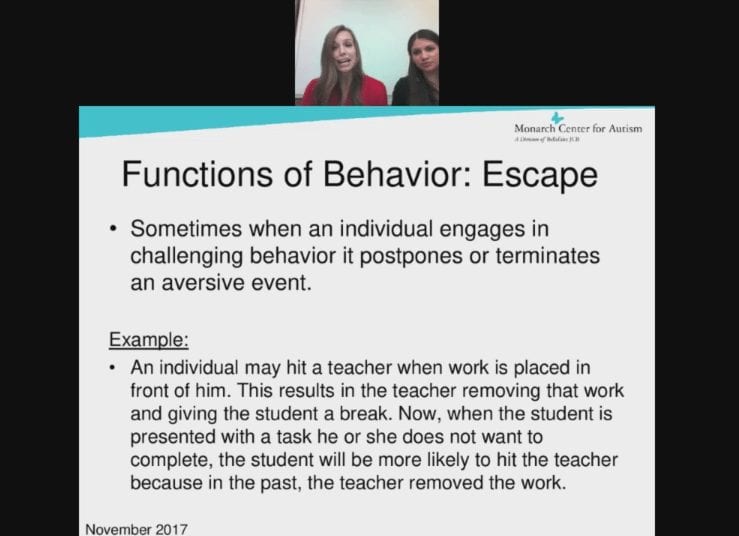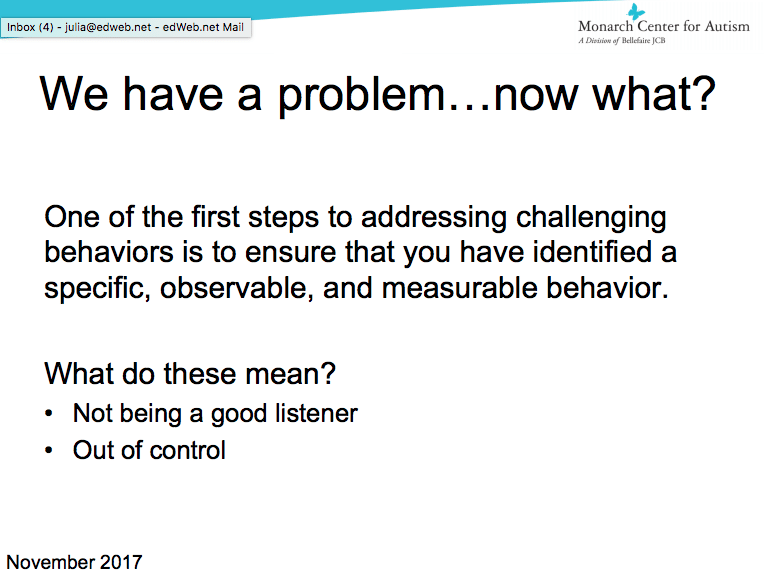Effectively Addressing Challenging Behaviors in Children with Autism
Challenging behaviors can be difficult to address in children with autism. After appropriately identifying the behavior, a suitable intervention can be used to proactively or reactively reduce and replace it. Experts reviewed key points and effective ways to address these problem behaviors in the edWebinar, “Effective Approaches to Reduce and Replace Challenging Behaviors Exhibited by Children with Autism.”
In order to address a behavioral problem, the behavior must first be defined. The behavior should be specific, observable, and measurable, and it should not be subjective. It’s crucial to have a baseline to tell if the intervention is working, and how well. Therefore, data collection is key when putting an intervention into place. Different methods of data collection can be used depending on the circumstance or how you plan to measure the behavior that’s occurring.
After identifying the behavior and collecting the data, what can be done to reduce or replace it? Proactive strategies may include a classroom checklist to make sure the environment is optimal for learning, the student has an effective way to communicate, there are enough opportunities for movement (depending on the age of the student), and more. Also, consider a replacement behavior: an alternative behavior-preferably one the student already knows-that can replace the challenging behavior. For example, teaching a student how to appropriately request a break from a lesson instead of crumpling paper or throwing materials.
Reactive strategies target what happens after the behavior has already occurred. One kind of reactive strategy is extinction, when a challenging behavior is no longer reinforced until the behavior stops occurring. This method shouldn’t be used without having taught an appropriate replacement behavior, the presenters mentioned. For example, if the student is calling out to get the teacher’s attention, the teacher doesn’t respond to the calls and instead responds only when the student raises their hand.
Finally, what if the behavior continues after interventions are put into place? Since challenging behavior is resistant to change, make sure everyone is on the same page and that the behavior is not intermittently being reinforced. Also, ensure that the alternate behavior is being reinforced by everyone, and that it is helpful for the student. Whenever an intervention is recommended, it should be a good fit for both the student and the environment, and there should be research on the effectiveness of it. Last, data should be collected on the behavior and should guide the intervention.
This broadcast was hosted by edWeb.net and sponsored by Monarch Center for Autism, STAR Autism Support, and VizZle.
This article was modified and published by eSchool News.
About the Presenters
Monica Fisher, M.Ed., BCBA/COBA has more than 14 years of experience working with children on the autism spectrum in home, school, and residential settings. She provides in-home consultative services for families in the community, and has provided trainings for parents, teachers, and other professionals. She earned her bachelor’s degree in psychology from the College of Wooster, her master’s degree and intervention specialist licensure from Cleveland State University, and she took coursework in applied behavior analysis through Florida Institute of Technology. She is the Director of the Behavior Department at Monarch Center for Autism and is responsible for managing a team of behavior specialists and BCBAs. She previously served as an intervention specialist in Monarch’s High School, and was formerly an associate teacher at Monarch School. She is also an independent behavioral consultant for ABA Outreach Services, providing behavioral consultative services for families of children with autism. Her experiences include working at Monarch Center for Autism, ABA Outreach Services, and with Milestones Autism Organization’s school Team Training program.
Judy Reynolds, M.Ed., Behavior Specialist at Monarch Center for Autism, received her undergraduate degree in psychology from U.C. Davis and her master’s degree from Arizona State University in curriculum and instruction in applied behavior analysis. She has been working with individuals with developmental disabilities for 12 years in the United States, Canada, and Israel. These experiences were predominantly as an in-home ABA therapist, camp instructor, teacher, and as a Behavior Intervention Implementer (BII) through LAUSD.
Join the Community
Teaching Students with Autism is a free professional learning community that provides ideas and resources for teachers working with students with autism, particularly advances in technology that can lead to significant breakthroughs in communication and learning.








Comments are closed.